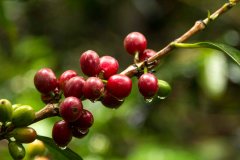The effect of coffee roasting on caffeine content The effect of caffeine on the body
Do you use coffee as an energy source for a busy day? Are you trying to avoid the effects of caffeine for health reasons? About 90% of the population in our country consumes caffeine every day. Most of the attraction of coffee is that it can easily wake you up and, perhaps more importantly, keep you alert. Whether you're looking for energy boost or drinking just for pleasure, it's important to understand the source of caffeine and how to choose coffee that contains the amount of coffee you need.

What is caffeine? In the simplest explanation, caffeine is an odorless alkaloid and mental stimulant that accelerates the central nervous system. In addition to coffee, caffeine is most common in tea, cocoa and Guarana, as well as as an additive in energy drinks or over-the-counter drugs. The effect of caffeine on the central nervous system varies from person to person. Some people may fall asleep immediately after drinking a cup of coffee, while others are more sensitive and become nervous or irritable. Once eaten, caffeine may take 45 minutes to be absorbed into the bloodstream, and the effect can last up to three hours.
Does the degree of baking affect caffeine?
Many factors affect the caffeine content of coffee beans: the type of coffee beans, the degree of roasting and, most importantly, brewing and measurement techniques. When choosing coffee beans, you must start from the source. There are two types of coffee trees: Arabica coffee and Robusta coffee. Arabica coffee is of higher quality and is the only coffee bean we offer. Robusta coffee beans are easier to grow and contain twice as much caffeine as Arabica varieties. So far, I have not seen any research showing whether coffee origin (Africa, Latin America, etc.) or processing methods affect the caffeine content of coffee beans. There is a common view that deep-roasted coffee is brightly colored, rich in flavor and contains the most caffeine. A popular objection is that lightly roasted coffee contains more caffeine because it takes less time to bake and therefore burns less caffeine. Facts have proved that both hypotheses are wrong. During the roasting process, the caffeine content of coffee remains relatively stable. The actual changes in the roasting process are the taste and caffeine content of the size and weight of coffee beans. When beans are roasted, they lose some moisture and overall mass. Beans that are deeply roasted or baked for the second time weigh significantly less than lightly roasted beans. The decline in quality and density is another reason that some people believe that deep-roasted coffee lacks caffeine.
How do you maximize (or minimize) your caffeine intake?

The measurement and grinding size of coffee beans will determine the caffeine content in your coffee. Because dark roasted coffee weighs less than light roasted coffee, a pound of dark roasted coffee contains more beans than a pound of light roasted coffee. For example, if you measure 20 grams of light-roasted and deep-roasted coffee beans, they both weigh the same, but deep-roasted coffee beans contain more caffeine because they require extra beans. If you are confused, please don't be sad. I had to read it several times by myself.
Important Notice :
前街咖啡 FrontStreet Coffee has moved to new addredd:
FrontStreet Coffee Address: 315,Donghua East Road,GuangZhou
Tel:020 38364473
- Prev

Change the taste and quality of coffee beans aged coffee beans and Swiss water-treated Fagorum coffee are grown
Generally speaking, coffee trees planted at low elevations have higher yields than those planted at high elevations. However, these high quantities will affect the quality of the final product. Like any plant, the transfer of nutrients from soil to fruit largely determines the quality and characteristics of the final product. The concept of local soil is very popular in the brewing industry and can be applied to many other agricultural sectors.
- Next

Starbucks Reserve Coffee beans Yunnan Coffee Yunnan Yellow Honey Coffee beans Flavor Historical Story
In 2012, Starbucks opened a Yunnan Farmer support Center in Pu'er. The goal is simple: to help farmers in Yunnan improve coffee quality while establishing CAFE (coffee and farm assets) practices to help ensure socially and environmentally responsible coffee production. Recently, Starbucks Aini Coffee Co. A joint venture initiative began to provide high-quality coffee beans to farmers in the area
Related
- Detailed explanation of Jadeite planting Land in Panamanian Jadeite Manor introduction to the grading system of Jadeite competitive bidding, Red bid, Green bid and Rose Summer
- Story of Coffee planting in Brenka region of Costa Rica Stonehenge Manor anaerobic heavy honey treatment of flavor mouth
- What's on the barrel of Blue Mountain Coffee beans?
- Can American coffee also pull flowers? How to use hot American style to pull out a good-looking pattern?
- Can you make a cold extract with coffee beans? What is the right proportion for cold-extracted coffee formula?
- Indonesian PWN Gold Mandrine Coffee Origin Features Flavor How to Chong? Mandolin coffee is American.
- A brief introduction to the flavor characteristics of Brazilian yellow bourbon coffee beans
- What is the effect of different water quality on the flavor of cold-extracted coffee? What kind of water is best for brewing coffee?
- Why do you think of Rose Summer whenever you mention Panamanian coffee?
- Introduction to the characteristics of authentic blue mountain coffee bean producing areas? What is the CIB Coffee Authority in Jamaica?

